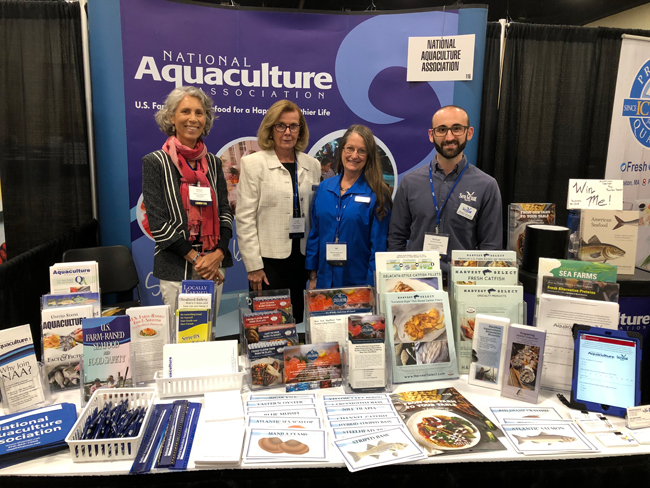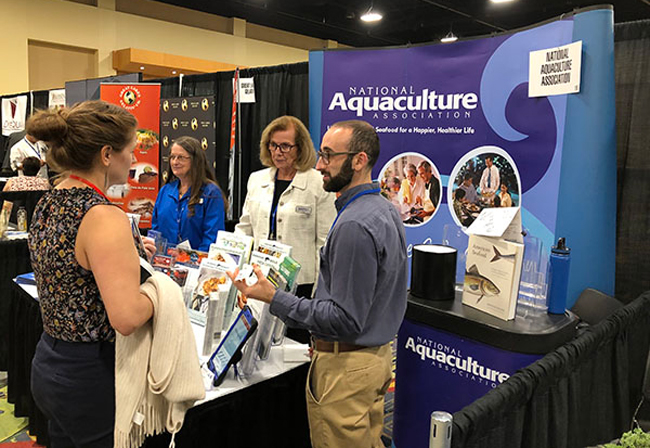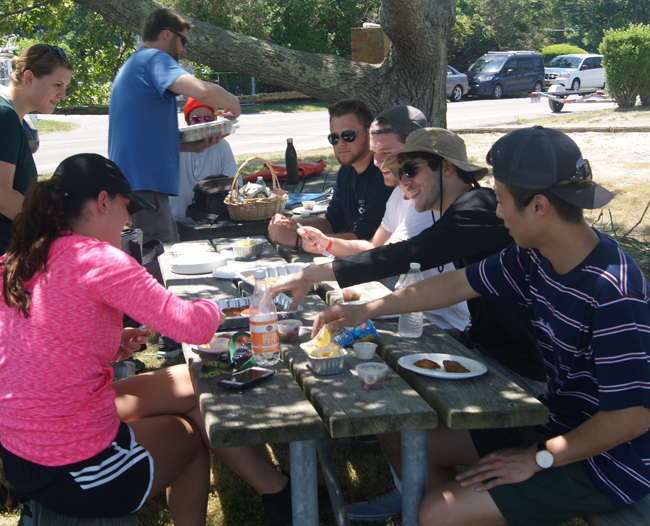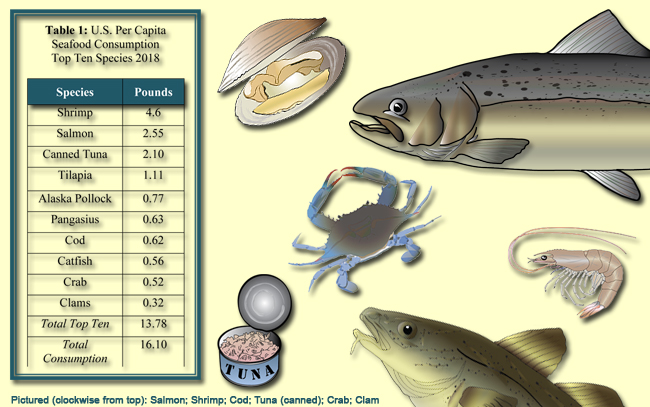
Michael Ciaramella (in the blue-gray shirt) and Linda O’Dierno (in the white jacket) appear with colleagues at the American Culinary Federation (ACF) conference in Orlando, 2019. Credit: Michael Ciaramella/NYSG.
— By Chris Gonzales, Freelance Science Writer, New York Sea Grant
Contact:
Michael Ciaramella, NYSG Seafood Safety & Technology Specialist, P: 631-632-8730, E: mc2544@cornell.edu
Stony Brook, NY, December 16, 2020 - New York Sea Grant (NYSG) and the National Aquaculture Association (NAA) offer an appealing idea for students who want to thrive post-COVID-19: It’s all about sustainable, local seafood.
Prior to the COVID-19 outbreak, two-thirds of seafood spending took place in restaurants and food service establishments. Now, with the quarantine, people are more likely to be cooking seafood at home. Producers, likewise, have made a big shift as they try to satisfy consumer needs by providing seafood for retail sale.

Ciaramella and O’Dierno interact with a participant at the ACF conference. Credit: Michael Ciaramella/NYSG.
Michael Ciaramella, a Cornell Cooperative Extension associate with New York Sea Grant, sees this big shift affecting future chefs. He believes the changes in consumer behavior we are seeing during the COVID-19 lockdown could become the new normal, affecting job opportunities for current students, as well as the topics culinary educators are teaching in the classroom today. He and colleague Linda O’Dierno of the National Aquaculture Association just published a paper in Café: Journal of Culinary Education Best Practices about their ideas.1
In addition, they have developed resources and ideas to help chefs better understand and take advantage of locally-farmed seafood. “These resources were created to help culinary educators navigate the complexities surrounding sustainable seafood production, specifically aquaculture,” said Ciaramella. “They were developed to highlight the different species that are farmed domestically and advise culinary educators on best practices for engaging farmers and sourcing such products.”
These resources are the product of a 2018 NAA project funded by the National Oceanic and Atmospheric Administration, Sea Grant’s federal parent agency.

Interns in the New York Fish to Dish program enjoy local, sustainable seafood after a morning on the water. Credit: Michael Ciaramella/NYSG.
Ciaramella and O’Dierno see a need for a workforce that is familiar with a variety of seafood products, including locally farmed seafood. They believe culinary educators can help future chefs explore new alternatives in the seafood industry. They are offering free resources and ideas to help educators build a comprehensive seafood program.
For example, in recent years, changes in border policy and tariffs have affected the seafood industry. Prior to the pandemic, 85-90% of the seafood consumed in the U.S. was imported. Approximately half of those imports were farm-raised, including notable examples shrimp, tilapia, and salmon. Some of this seafood was U.S.-sourced, then sent overseas for processing before being re-imported.
Demand and prices for seafood have been depressed since the pandemic began.
Consumers, meanwhile, are often unsure how to get fresh, quality seafood, or how to prepare it. They often view seafood as an occasional treat when dining out.
The double-edged sword of the pandemic and tariff policy is affecting imports of seafood. Meanwhile, locally farmed and fished seafood is gaining market share.

Credit: Illustrations by Michael Ciaramella.
There are many seafood species beyond just the top ten most common (detailed in the table above). But consumers are often initially hesitant to try something new.
Ciaramella and O’Dierno see opportunity for entrepreneurs creating meal kits and easy-to-follow recipes.
Unfortunately, many culinary schools do not offer specialized seafood courses, says O’Dierno.
Even so, the health benefits of seafood are well-established: it can promote a healthy brain, eyes, muscles, and heart.
Sourcing locally can also be more sustainable, Ciaramella points out, reducing the distance food has traveled and thus its carbon footprint. He adds that fishing and farming in U.S. waters is well-regulated to be managed sustainably.
He and O’Dierno are offering resources and ideas for educators to pass along to future chefs. The topics center around high quality take-away and delivery options; recipe writing and creation; safety protocols; gaining experience to make quality meal kits; and marketing.
Thus, if the future of seafood has been looking foggy for students and educators, Ciaramella is offering free resources that will help them not only see clearly, but thrive.
References
1Ciaramella, M. & O’Dierno, L. (2020). Culinarians Role in Seafood Preparation Post COVID-19. Journal of Culinary Education Best Practices COVID-19 Special Edition (3)1.
More Info: New York Sea Grant
New York Sea Grant (NYSG), a cooperative program of Cornell University
and the State University of New York (SUNY), is one of 34 university-based
programs under the National Oceanic and Atmospheric Administration’s
National Sea Grant College Program.
Since 1971, NYSG has represented a statewide network of integrated
research, education and extension services promoting coastal community
economic vitality, environmental sustainability and citizen awareness
and understanding about the State’s marine and Great Lakes resources.
Through NYSG’s efforts, the combined talents of university scientists
and extension specialists help develop and transfer science-based
information to many coastal user groups—businesses and industries,
federal, state and local government decision-makers and agency managers,
educators, the media and the interested public.
The program maintains Great Lakes offices at Cornell University, SUNY
Buffalo, SUNY Oswego and the Wayne County Cooperative Extension office
in Newark. In the State's marine waters, NYSG has offices at Stony Brook
University in Long Island, Brooklyn College and Cornell Cooperative
Extension in NYC and Kingston in the Hudson Valley.
For updates on Sea Grant activities: www.nyseagrant.org has RSS, Facebook, Twitter, Instagram, and YouTube links. NYSG offers a free e-list sign up via www.nyseagrant.org/nycoastlines for its flagship publication, NY Coastlines/Currents, which is published quarterly. Our program also produces an occasional e-newsletter,"NOAA Sea Grant's Social Media Review," via its blog, www.nyseagrant.org/blog.